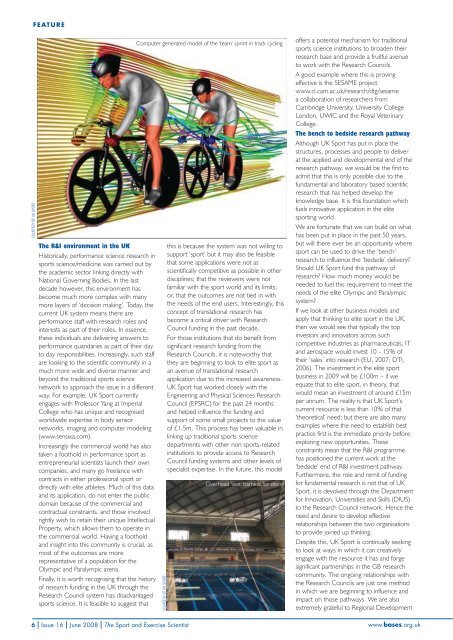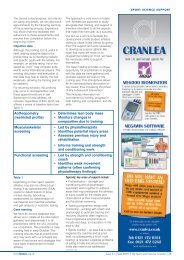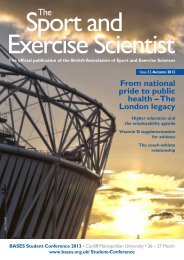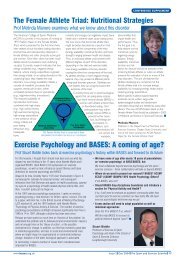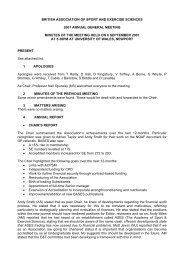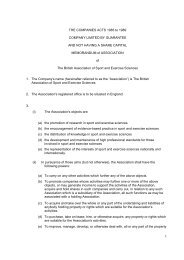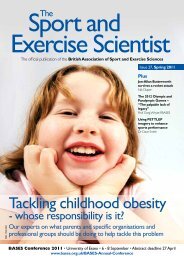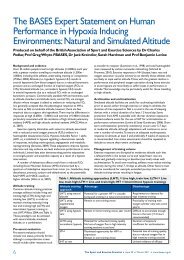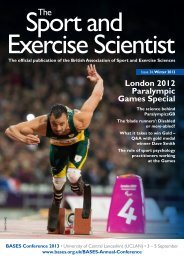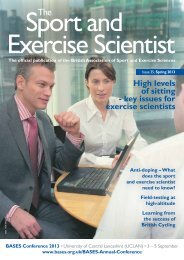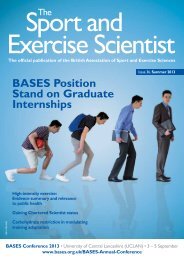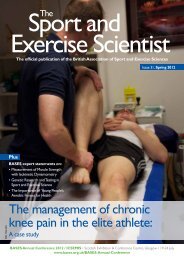Part 1 - Bases
Part 1 - Bases
Part 1 - Bases
- No tags were found...
Create successful ePaper yourself
Turn your PDF publications into a flip-book with our unique Google optimized e-Paper software.
FEATURECOURTESY OF UK SPORTThe R&I environment in the UKHistorically, performance science research insports science/medicine was carried out bythe academic sector linking directly withNational Governing Bodies. In the lastdecade however, this environment hasbecome much more complex with manymore layers of ‘decision making’. Today, thecurrent UK system means there areperformance staff with research roles andinterests as part of their roles. In essence,these individuals are delivering answers toperformance quandaries as part of their dayto day responsibilities. Increasingly, such staffare looking to the scientific community in amuch more wide and diverse manner andbeyond the traditional sports sciencenetwork to approach the issue in a differentway. For example, UK Sport currentlyengages with Professor Yang at ImperialCollege who has unique and recognisedworldwide expertise in body sensornetworks, imaging and computer modeling(www.sensixa.com).Increasingly the commercial world has alsotaken a foothold in performance sport asentrepreneurial scientists launch their owncompanies, and many go freelance withcontracts in either professional sport ordirectly with elite athletes. Much of this dataand its application, do not enter the publicdomain because of the commercial andcontractual constraints, and those involvedrightly wish to retain their unique IntellectualProperty, which allows them to operate inthe commercial world. Having a footholdand insight into this community is crucial, asmost of the outcomes are morerepresentative of a population for theOlympic and Paralympic arena.Finally, it is worth recognising that the historyof research funding in the UK through theResearch Council system has disadvantagedsports science. It is feasible to suggest thatComputer generated model of the 'team' sprint in track cyclingCOURTESY OF UK SPORTthis is because the system was not willing tosupport ‘sport’ but it may also be feasiblethat some applications were not asscientifically competitive as possible in otherdisciplines; that the reviewers were notfamiliar with the sport world and its limits;or, that the outcomes are not tied in withthe needs of the end users. Interestingly, thisconcept of translational research hasbecome a critical driver with ResearchCouncil funding in the past decade.For those institutions that do benefit fromsignificant research funding from theResearch Councils, it is noteworthy thatthey are beginning to look to elite sport asan avenue of translational researchapplication due to this increased awareness.UK Sport has worked closely with theEngineering and Physical Sciences ResearchCouncil (EPSRC) for the past 24 monthsand helped influence the funding andsupport of some small projects to the valueof £1.5m. This process has been valuable inlinking up traditional sports sciencedepartments with other non sports-relatedinstitutions to provide access to ResearchCouncil funding systems and other levels ofspecialist expertise. In the future, this modelOverhead 'wet' harness for divingoffers a potential mechanism for traditionalsports science institutions to broaden theirresearch base and provide a fruitful avenueto work with the Research Councils.A good example where this is provingeffective is the SESAME projectwww.cl.cam.ac.uk/research/dtg/sesamea collaboration of researchers fromCambridge University, University CollegeLondon, UWIC and the Royal VeterinaryCollege.The bench to bedside research pathwayAlthough UK Sport has put in place thestructures, processes and people to deliverat the applied and developmental end of theresearch pathway, we would be the first toadmit that this is only possible due to thefundamental and laboratory based scientificresearch that has helped develop theknowledge base. It is this foundation whichfuels innovative application in the elitesporting world.We are fortunate that we can build on whathas been put in place in the past 50 years,but will there ever be an opportunity wheresport can be used to drive the ‘bench’research to influence the ‘bedside’ delivery?Should UK Sport fund this pathway ofresearch? How much money would beneeded to fuel this requirement to meet theneeds of the elite Olympic and Paralympicsystem?If we look at other business models andapply that thinking to elite sport in the UK,then we would see that typically the topinvestors and innovators across suchcompetitive industries as pharmaceuticals, ITand aerospace would invest 10 - 15% oftheir ‘sales’ into research (EU, 2007; DTI,2006). The investment in the elite sportbusiness in 2009 will be £100m – if weequate that to elite sport, in theory, thatwould mean an investment of around £15mper annum. The reality is that UK Sport’scurrent resource is less than 10% of that‘theoretical’ need; but there are also manyexamples where the need to establish bestpractice first is the immediate priority beforeexploring new opportunities. Theseconstraints mean that the R&I programmehas positioned the current work at the‘bedside’ end of R&I investment pathway.Furthermore, the role and remit of fundingfor fundamental research is not that of UKSport, it is devolved through the Departmentfor Innovation, Universities and Skills (DIUS)to the Research Council network. Hence theneed and desire to develop effectiverelationships between the two organisationsto provide joined up thinking.Despite this, UK Sport is continually seekingto look at ways in which it can creativelyengage with the resource it has and forgesignificant partnerships in the GB researchcommunity. The ongoing relationships withthe Research Councils are just one methodin which we are beginning to influence andimpact on those pathways. We are alsoextremely grateful to Regional Development6 l Issue 16 l June 2008 l The Sport and Exercise Scientist www.bases.org.uk


